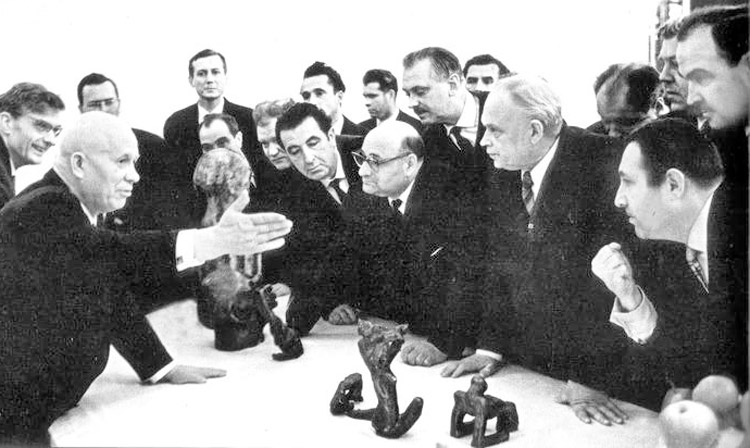Ernst Neizvestny was a Russian sculptor whose modernist works, despite determined efforts by the Stalinist officialdom of the time to suppress them, left a tribute that stands today to the memory of millions thrown into labor camps or killed resisting the regime’s repression.
In 1996, a few years after the disintegration of the Soviet Union, Neizvestny’s 50-foot concrete monument, the Mask of Sorrow, was erected at Magadan, a port city on Siberia’s Pacific coast. Its picture was printed in last week’s Militant.
It is dedicated to tens of thousands of political prisoners who perished laboring in gold mines there. The powerful sculpture is close to the Road of Bones, which was literally built over the remains of up to a million prisoners who worked on it. In 1946, many Soviet Union army veterans were sent there, falsely accused by the regime of Joseph Stalin of collaborating with the enemy. Their “crime” was being held prisoners of war by German forces.
A follow-up memorial by Neizvestny titled the Masks of Sorrow, with twin weeping faces, one facing east, the other west, was dedicated to all those who died in the Stalinist Gulag. It was commissioned by the municipal government in Neizvestny’s birthplace, the central Russian city of Yekaterinburg. Hidden away by Russian authorities for 27 years, it was finally publicly displayed in 2017. Unfortunately, the artist died the year before.
In Art & Revolution: Ernst Neizvestny, Endurance, and the Role of Art, noted critic John Berger explains that in 1942, during the Nazi invasion of the Soviet Union, Neizvestny volunteered for military service at age 16.
He wrote a poem, a prophetic image of the heavy Russian losses in Moscow’s war on Ukraine today, which reads:
The living and the corpses embracing.
In blood.
No disgust. Soon we’ll all be dead. …
Anyone from the Second Storm Battalion still alive?
He was badly wounded and left for dead. Some 20 years later he was awarded — posthumously, the authorities assumed — the Order of the Red Star.
Incredibly, he had survived. “In the intervening years, no one had made the connection between Lieutenant Neizvestny — missing patriot, presumed dead — and a notorious, officially condemned, decadent and ‘unpatriotic’ sculptor of the same name,” Berger wrote.
Neizvestny’s modernistic style led him to clash with Soviet cultural authorities. Frustrated by official obstruction to his and other artists’ work, he emigrated in 1976, eventually settling in New York.
Cracks in Stalinist monolith
In a secret speech given to a closed plenum of the Communist Party in 1956, Soviet Premier Nikita Khrushchev denounced Stalin’s “cult of personality.” For the first time, the scale of Stalin’s purges in the late 1930s and the huge system of punitive labor camps, the Gulag, was revealed.
Khrushchev’s “revelations” showed that the Stalinist totalitarian monolith was cracking. Heroic working-class-led uprisings followed that year in Hungary and Poland, fighting for workers’ democracy. Both were brutally suppressed at Khrushchev’s orders.
As cultural policy in the post-Stalin era began to loosen, Neizvestny in 1962 joined other abstract artists in putting on a large exhibition in Moscow. It was sponsored by the Soviet Artists’ Union.
The sensational art show drew such huge crowds that the Kremlin felt compelled to shut it down. Khrushchev personally showed up, angrily denouncing the avant-garde art as “s–t” and a “disgrace,” Berger recounts.
Neizvestny confronted him. “Here in front of my works,” he said. “I am premier, and we shall discuss as equals.”
Art under Stalin was ‘rotten’
An argument erupted, with the sculptor telling Khrushchev that he “was neither an artist nor a critic and was illiterate when it came to aesthetics.” He told the Soviet premier that art, falsely labeled as “socialist realism” under Stalin, was “rotten.”
“The methods Stalin used served the cult of personality and this became the content of the art he allowed,” Neizvestny said. “Therefore the art was rotten too.”
Under the Stalinist regime, both before and after his death, artistic expression deemed threatening to its counterrevolutionary interests was not only censored but brutally suppressed.
Khrushchev shook Neizvestny’s hand, but left with a threat. “Inside you there are an angel and a devil,” he said. “If the devil wins, we’ll crush you. If the angel wins, we’ll do all we can to help you.”
Neizvestny paid a price for his boldness. He was barred from official work for several more years. But when Khrushchev died in 1971, his family commissioned Neizvestny to create his gravestone monument.
At the time of Neizvestny’s death in 2016, Putin declared it “a grievous loss for Russia’s culture and for world culture.” He said the controversial artist was “one of the greatest sculptors of our time.”
The following year, a museum holding a wide range of Neizvestny’s sculptures and paintings was opened in Yekaterinburg alongside the Masks of Sorrow. One local official noted that “hundreds of thousands of people from the Urals suffered during the years of mass repression.” Another said regular visitors would help “preserve the memory and prevent the recurrence of similar events.”
Now, the Putin regime is reversing that message, clamping down on artistic freedoms as it deepens its course of repression at home and his war on Ukraine bogs down. A key part of this is whitewashing the crimes of Stalin.
In 2016, the giant Mask of Sorrow was vandalized by graffiti saying, “Stalin lives.” But it still stands as a powerful protest against the regimes of both Stalin and Putin.


